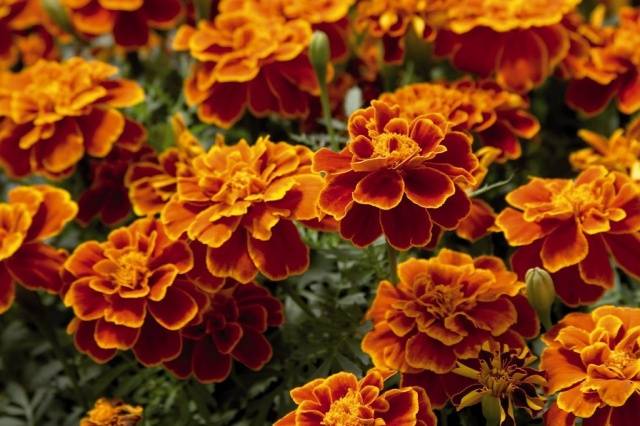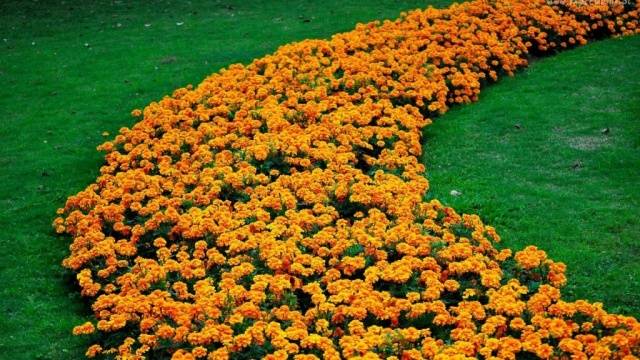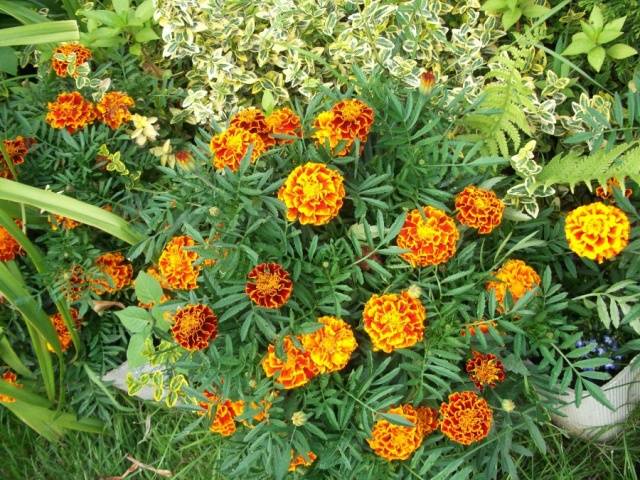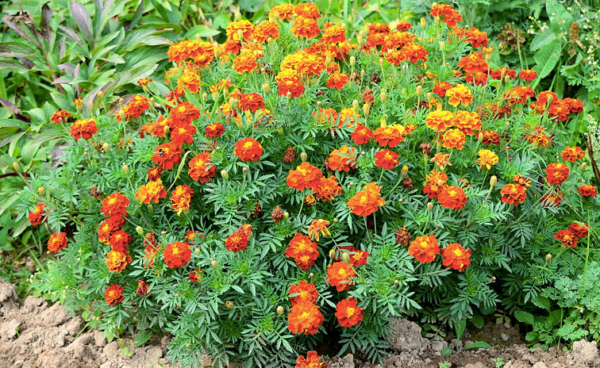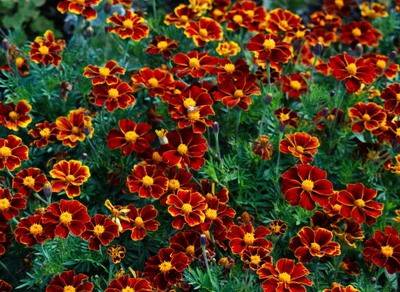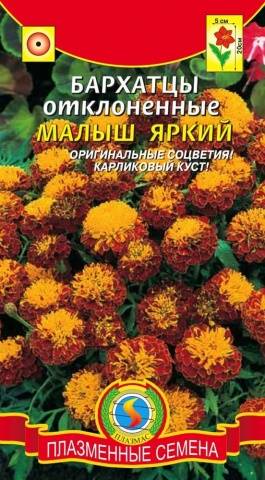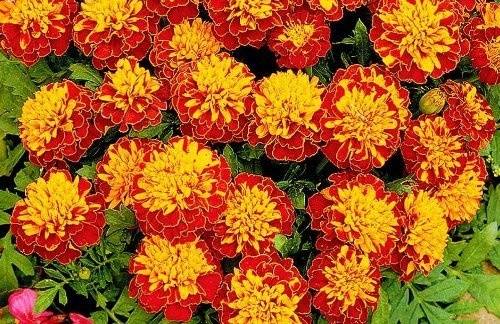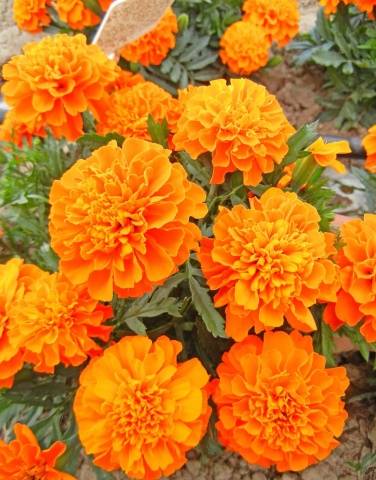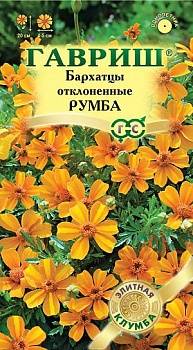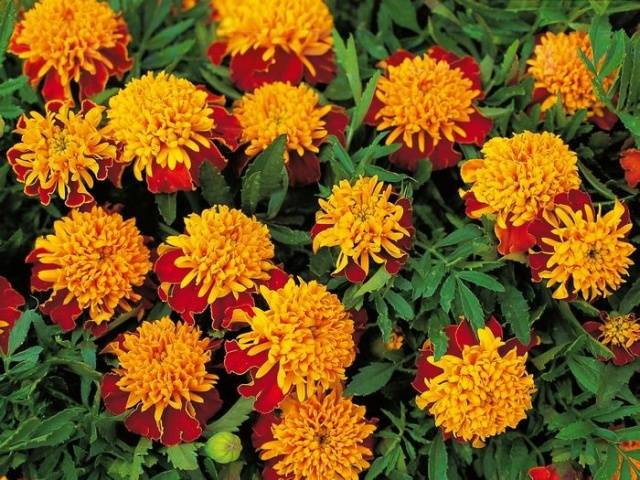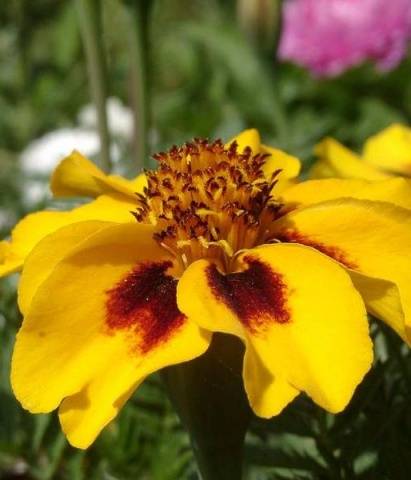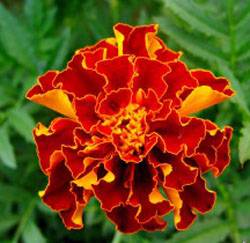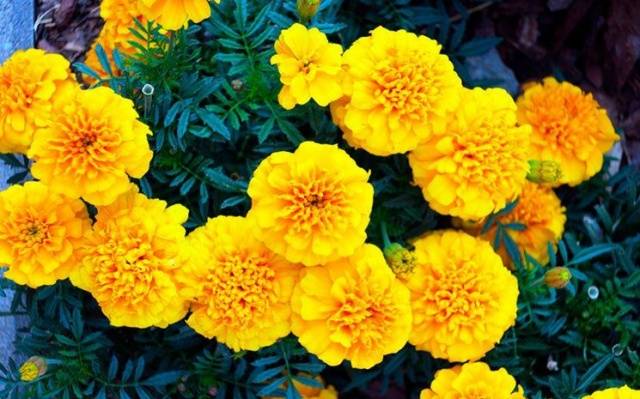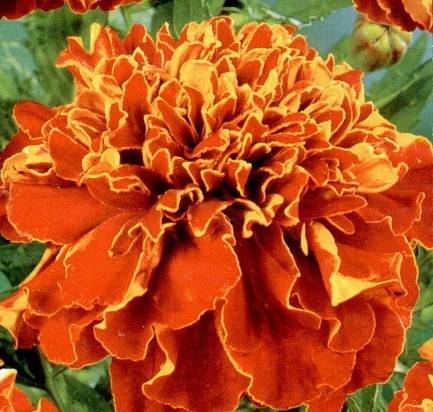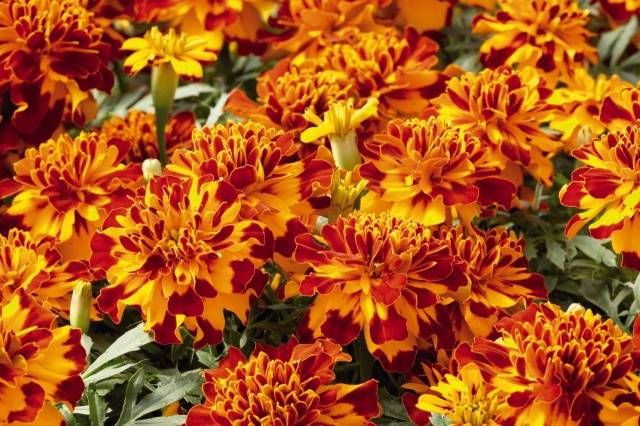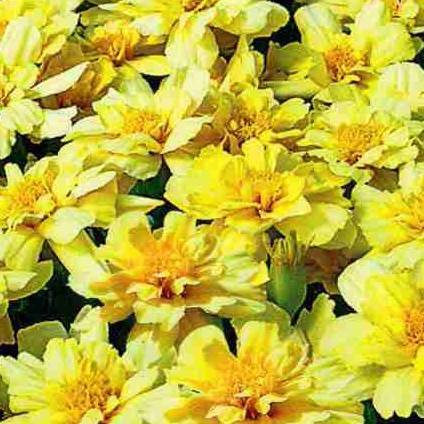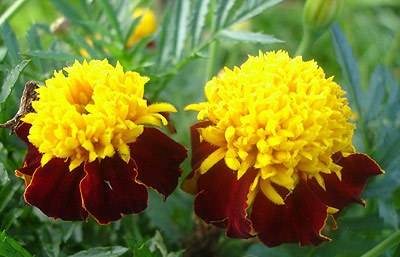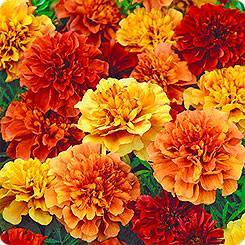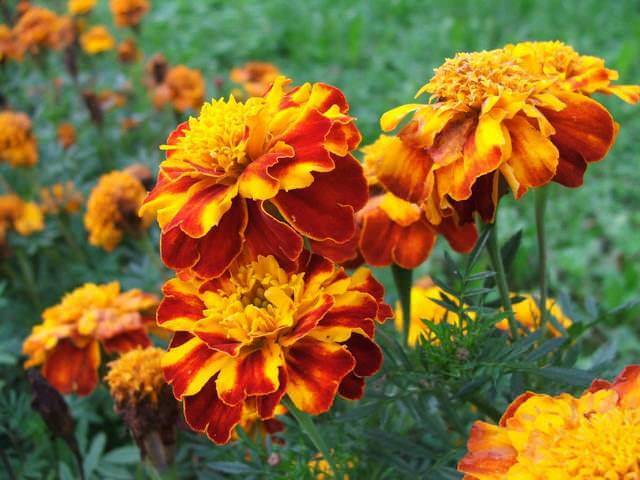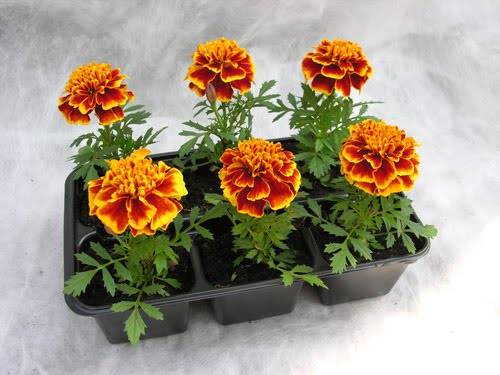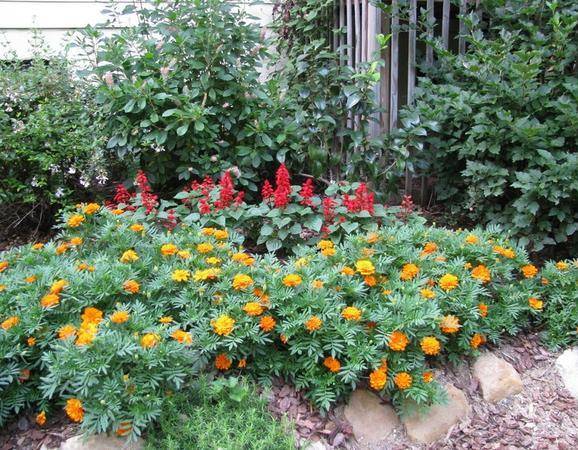Content
Flowers that can take first place among annuals in terms of prevalence and popularity, possessing not only medicinal and nutritional value, but also capable of scaring off many pests and pathogens. Many probably guessed that we are talking about marigolds. It is these sunny, cheerful flowers that can revive and cheer up even on a gloomy, cloudy day, in a period of bad mood or even depression.
Marigolds have varieties only with yellow, orange and red shades and their combination. But what a unique variety of looks different combinations of these three colors can give.
Botanists know about 30 species of these plants, but only 2-3 species are most popular in Russia: rejected marigolds, erect marigolds and relatively recently appeared thin-leaved marigolds. And the number of varieties has already exceeded several hundred long ago and continues to increase every year.
Among them there are both perennial and annual plants, but in our country only annual varieties of marigolds are grown. They belong to the Aster family. The flowers got their Latin name Tagetes thanks to Karl Linnaeus, who was amazed at their beauty and named them in honor of Jupiter's grandson, the demigod Tages, who was distinguished by his beauty and the ability to see the future.
In each country, they noticed some special features of the Tagetes and recorded them in the local names of the flower. In Russia, they were called marigolds for the velvety surface of the petals, which is especially pronounced with the dark color of flowers. In England they are called "Mary's gold", and in Germany - "student's flower". In China they were called "flowers of thousands of years", and in Ukraine - black-haired people.
This article will focus on the rejected marigolds, since it is these flowers, first of all, that our mothers and grandmothers associate with marigolds.
General description of plants
Rejected marigolds are drought tolerant, thermophilic annual herbaceous plants for outdoor use. Although, due to their unpretentiousness, including the level of illumination, they can be successfully grown on balconies, and even at home.
These flowers are native to the mountainous regions of Mexico.
The stems are very strong and strong, the central shoot grows straight, all the lateral ones deviate and branch from the very base. The result is either compact or sprawling bushes 15 to 60 cm in height. The leaves are pinnately dissected, with a serrated edge, dark green in color, can be arranged either in turn or in opposite order. The inflorescences are baskets from 4 to 6 cm in diameter, very diverse in shape, characterized by rather long peduncles. On the edge, reed flowers are usually located, which can be of a wide variety of shades - orange, yellow, lemon, dark red, brownish, brown.They are even two-colored and speckled with specks of different sizes, velvety to the touch.
In the middle of the inflorescence, as a rule, there are tubular flowers that are yellow or orange. The fruit is an elongated achene. The seeds do not lose their ability to germinate within 3-4 years. Flowers can produce abundant self-seeding. There are from 300 to 700 seeds in 1 gram.
In the open field they bloom profusely from June to the first frost. In a greenhouse or at home, rejected marigolds are able to bloom year-round when appropriate lighting is created. This type of marigold has been successfully bred since the 16th century.
Plants have a rather pungent, peculiar smell that can scare away many harmful insects and other animals. And the leaves smell even stronger than flowers.
Rejected marigolds are highly resistant to diseases and pests, and tolerate drought well.
Differences between rejected marigolds and erect marigolds
The rejected marigolds are also called French, since they got their distribution throughout Europe thanks to the French Huguenot refugees, who in the middle of the 16th century, moving to other countries, took the seeds of these flowers with them. Rejected marigolds were among the first overseas plants to migrate to Russia around the 18th century.
Actually rejected they began to be called according to the features of all lateral stems deviate in different directions.
As a result, the bushes look rather squat and spreading, and undersized varieties form almost solid flowering carpets.
What is the difference between rejected marigolds from other species, and, above all, erect ones? After all, outwardly from the outside, they seem very similar and, due to their beauty and unpretentiousness, are equally popular among flower growers.
- First, they differ in the structure of the stem. In erect marigolds, it does not branch from the base, but grows straight and even often lignifies at the base.
- Secondly, only one inflorescence grows on one stem of upright marigolds, while a whole bunch of rejected marigolds can grow.
- Rejected marigolds are usually small in size and reach a maximum height of 60 cm.And among the upright ones there are real giants, up to 120 cm high.
- Rejected marigolds are characterized by a wide variety of flower colors - almost all varieties are two-tone. And among the erect ones, only plain flowers can be found.
-
In terms of the variety of flower shapes, the rejected marigolds also went far ahead. Among the varieties, there are simple and double, and similar to chrysanthemum, and anemone. The inflorescences of erect marigolds are all terry, similar to a lush ball.
- Finally, these two species differ somewhat in terms of growing season and whimsicality. Rejected marigolds bloom faster and easier and can grow in almost any conditions (in terms of humidity, the amount of light and ecology, for example, along the sides of large roads and in gas-polluted regions.)
Classification of marigolds
All varieties of marigolds rejected can be conditionally divided into several groups according to the shape of the flower:
- Simple - The inflorescence basket consists of one layer of reed flowers along the edge and tubular in the center.
- Carnation - inflorescences consist mainly of reed flowers, can be simple, semi-double and double.
- Chrysanthemum - consist mainly of tubular flowers, are usually double.
- Mixed type - when ligulate flowers are located at the edges, and the middle of the inflorescence is filled with tubular flowers.
Variety of varieties
Thanks to the combination of different shades with different shapes and sizes of inflorescences, many varieties of rejected marigolds were obtained, which delight in their dissimilarity to each other. Everyone can choose among them something to their liking.
Dwarf marigolds, up to 20 cm high
Dwarf marigold varieties appeared relatively recently, but managed to gain popularity, especially in industrial floriculture. Since they can be used to make carpets of flowers, amazing in the colorfulness of patterns.
Kid
This is a whole series of varieties of different colors, up to 20 cm high. There is a bright baby, gold baby, orange baby and others. The bushes of this variety are super compact and even. Terry inflorescences with a predominance of reed flowers can reach 5 cm in diameter. They bloom early, bloom long and profusely.
Harmony
This amazing variety lives up to its name. With a low bush height, the flowers reach 5 cm in diameter. Dense and dense bushes can reach 25-30 cm in width. There are so many flowers that sometimes foliage is not visible under them. The inflorescences themselves are bicolor, mixed in shape, terry - unusually harmonious. In addition, they easily withstand bad weather and perfectly retain their shape during the entire warm period.
Primo
Another series of varieties of dwarf marigolds rejected of a monochromatic color, among which there is a sub-variety of an amazing shade - apricot primo.
Rumba
The inflorescences are the simplest, single-row ones, but alternating orange and bright yellow colors can be traced on the petals, which makes the flowers unusual and additional volume. Despite their miniature size, the bushes are distinguished by their strength and strength, successfully withstanding all weather disasters.
Eye of the Tiger
One of the most popular varieties. Lush terry golden color of the inflorescence core is bordered by a single row of reed petals of deep dark red color. The color is a bit like harmony, but the middle is more luxuriant.
Low, from 25 to 40 cm
This group includes the absolute majority of the most famous rejected marigolds. And this is no accident - breeders simply satisfy the needs of flower growers who are very comfortable to deal with bushes of this size.
Rock'n'roll
The variety has the simplest inflorescences in shape, but maroon specks on a lemon background give it sophistication.
Cherry bracelet
The flowers have a unique corrugated petal shape with a variegated two-tone color.
Hero's Gold
The inflorescences are solid yellow in color, but petals of different shape and size create a bewitching sight.
Aspen
Densely double inflorescences of dark shades adorn the splashes of bright sunny color.
Bolero
One of the most popular varieties of rejected marigolds. In terms of brightness and multicolor, there are few similar colors.
Aluminum
How unusual marigolds look with a yellow-cream shade. This unique variety is still the only one of its kind. In addition, the plants are distinguished by ultra-early flowering periods.
Gold head
The flowers of these marigolds immediately stand out against the general background and the contrast of color shades, and the shining center.
Chameleon pink
This luxurious variety was born thanks to the efforts of American breeders.
Thus, on one bush, you can observe flowers of several shades at once. In addition, flowers have powerful vitality, like all rejected marigolds.
Medium and high grades, from 40 to 60 cm
Medium and tall varieties of rejected marigolds are not so numerous. In this size niche, erect marigolds are much more common, but still several varieties are worth mentioning.
Cheerful clown
The bushes of this variety can reach a height of 60-70 cm. The diameter of the flower is 6 cm. The inflorescences are the most common, but it is impossible to resist the unique, pleasing to the eye colors.Thanks to the long stems, the flowers can be cut for bouquets, and they can last a long time in the water.
Golden ball
Simple inflorescences of the most common, non-double form, nevertheless, cannot leave anyone indifferent. The bushes reach a height of 50-60 cm.
Sowing and growing
Rejected marigolds can be grown either by sowing directly into open ground around mid-May, or by seedling. The period from germination to flowering in these flowers is about two months. Accordingly, if you want to enjoy the flowering of marigolds from the beginning of June, then sow them for seedlings in early April.
Seeds sprout 5-10 days after planting.
Rejected marigolds are considered the most undemanding of all species to soil and growing temperatures. Seedlings grown in a greenhouse or greenhouse will turn out to be especially strong and hardened.
These flowers tolerate picking and transplanting well at any age, and even in a flowering state.
When growing seedlings of marigolds at home, experienced florists recommend germinating the seeds first in order to sow them then with optimal density. To do this, they must be laid out on a damp cloth, placed in a transparent plastic container or bag and placed in a warm place. After a few days, the seeds can be picked.
Seeds with tiny sprouts that have sprouted should be carefully laid out in shallow grooves at a distance of 1.5 - 2 cm from each other and covered with a small layer of light earth, 0.5 cm thick. Sprinkle well on top and place in a bag so that the sprouts do not die from drying out.
When seedlings appear, the container with seeds is placed in a cooler (+ 16 ° + 20 ° C) and bright place.
In open ground, the seedlings of rejected marigolds can be planted in early June in the middle lane.
Using colors
Rejected marigolds are unique flowers that can not only decorate a flower bed and a balcony, but also protect your garden and vegetable garden from uninvited guests.
- If you grow them on unused land and then plow them into the ground, you can free the soil from nematodes and fusarium.
- When planting marigolds in the garden, they are able to protect potatoes from the Colorado potato beetle, and cabbage, cucumbers, tomatoes and other vegetables from many crawling and flying pests. They are poorly combined only with plants from the legume family.
-
When planting marigolds in flower beds, they scare away aphids from roses and help asters and other rot-prone flowers feel better.
- Dried and crushed flowers, buds and leaves of marigolds serve as a good spice for preserving and preparing various dishes.
- Marigolds play a significant role in traditional medicine. Flowers and leaves have antiviral, laxative, sedative and anthelmintic effects.
It is difficult to imagine more popular, easy to care for and at the same time so versatile in use flowers than rejected marigolds. On each site there is sure to be a place where you can apply these wonderful and useful plants.
